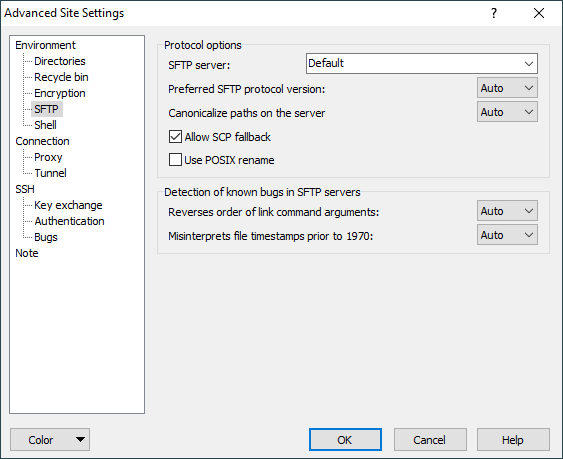The SFTP Page (Advanced Site Settings dialog)
The SFTP page on the Advanced Site Settings dialog allows user to configure SFTP protocol specific options.
Advertisement
To reveal this page you need to select SFTP file protocol on Login dialog.
Refer to documentation of page sections:
Protocol Options
Use SFTP server to specify path to SFTP server binary. Keep value Default to use the default SFTP server. Usually there will not be more SFTP servers to choose from. However you may find the option useful to change the way the SFTP server is launched. Particularly you may want to change user (known as su).1
Use Preferred SFTP protocol version to configure maximal version of SFTP protocol that WinSCP will attempt to use. WinSCP will seamlessly downgrade to any lower version that the server supports. In the latest beta version, with the default Auto value, WinSCP will use the last version 6 with well known and tested SFTP servers and stable version 3 with others. The only reason, that you may want to change the option for, is bug either in SFTP server or WinSCP itself specific to particular version of the protocol or if you know that your non-mainstream SFTP server has good support for a newer version.
Adhering to the SFTP specification, when changing directory, WinSCP asks the SFTP server to canonicalize the new path.2 With OpenSSH (and possibly other) SFTP servers this has side effect that the symbolic links in the path are resolved, what can complicate navigation back. Some minor SFTP servers even have this functionality broken. For either of these reasons, you may want to turn the canonicalization off, by unchecking Canonicalize paths on the server.
Advertisement
By default SFTP has option Allow SCP fallback enabled. With the option enabled, WinSCP tries to find SFTP server and when it fails, it initiates SCP protocol. Note that, when fallback is disabled, WinSCP tries harder using non-standard methods to find the SFTP server. You can see the protocol actually used on the Server and Protocol Information Dialog. SCP fallback cannot be combined with a custom path to SFTP server binary.
The Use POSIX rename enables use of OpenSSH posix-rename@openssh.com SFTP extension to rename files with POSIX semantics, instead of the standard SFTP rename.
Detection of Known Bugs in SFTP Servers
The box allows you to configure the bugs WinSCP should expect to see in the SFTP server.
Each bug can be configured in three states. With Off WinSCP will assume that the server does not have the bug. With On WinSCP will assume that the server does have the bug. With Auto (default) WinSCP will try to guess whether or not the server has the bug. The guessing is mostly based on software version string of the SSH server, as most current SFTP servers does announce their software version strings.
WinSCP can work around the bugs of major SFTP servers only. There is many more known bugs in SFTP server implementations. Read more about interoperability with SFTP servers.
Reverses Order of Link Command Arguments
The SFTP command to create a link has two arguments: the path the link should point to and the path of the link itself. Some servers incorrectly expects the arguments in reversed order.
If the bug is detected, WinSCP will reverse the order of the arguments too.
The bug is known for symbolic links on SFTP servers shipped with all versions of OpenSSH (bug #861) and on ProFTPD mod_sftp server (bug #4080). For hard links, the bug is known on all current versions3 of SFTP servers shipped with ProFTPD mod_sftp server (bug #4080).
Misinterprets File Timestamps Prior to 1970
While specification for SFTP protocol version 3 and older defines file timestamp to be unsigned 32-bit number representing number of seconds from Jan 1, 1970 in UTC, at least OpenSSH interprets it as signed number. The result is that files on the server with timestamps before 1970 will be interpreted by WinSCP as times after 2038. As it is probably quite common bug, it is currently considered to apply for all servers. Set the option to Off if it does not for your server.
This is SFTP-3 and older specific bug. SFTP-4 introduced signed 64-bit timestamps.
Further Reading
Read more about Login dialog and Advanced Site Settings dialog.
